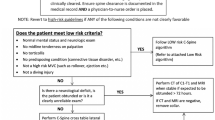Abstract
Introduction: Clearance of cervical spine injuries is essential in blunt trauma patients. Commonly used screening guidelines (NEXUS and Canadian C-spine rules) consider a negative physical examination unreliable in patients with distracting injuries (DI) and require further radiographic imaging to rule out cervical spine injury. Recent literature advocates for more judicious radiographic criteria in patients with DI, citing resource utilization concerns and new data showing improved safety. We aim to review the current evidence for recommendations when clearing the cervical spine in blunt trauma patients who are alert, awake, have no neurologic deficits but do have distracting injuries.
Methods: We performed a literature review of PubMed, Cochrane Evidence-Based Medicine, and guidelines from Eastern Association for the Surgery of Trauma (EAST), Western Trauma Association (WTA) and Advanced Trauma Life Support (ATLS) to include five relevant studies from 2001 to 2019.
Results: There are few studies, with no randomized controlled trials, evaluating clearance of the cervical spine in blunt trauma patients with DI. The missed rate of cervical spine injuries in DI patients ranged from 0.2% to 13%. The definition of DI had varied definitions without consistency throughout the studies. Multiple studies showed an association with a higher miss rate in upper torso DI compared to lower torso. The EAST, WTA, and ATLS guidelines adhere closely to the NEXUS and Canadian C-Spine rules and include additional imaging for patients with DI.
Recommendation: Blunt trauma patients who are alert, awake, without neurologic deficits but do have distracting injuries require additional imaging to clear the cervical spine. However, omission of additional imaging may be considered in patients with isolated lower torso distracting injuries.
Access this chapter
Tax calculation will be finalised at checkout
Purchases are for personal use only
Similar content being viewed by others
References
Ackland HM, Cooper JD, Malham GM, Kossmann T. Factors predicting cervical collar-related decubitus ulceration in major trauma patients. Spine. 2007;32:423–8.
Chendrasekhar A, Moorman DW, Timberlake GA. An evaluation of the effects of semirigid cervical collars in patients with severe closed head injury. Am Surg. 1998;64:604–6.
Powers J, Daniels D, McGuire C, Hilbish C. The incidence of skin breakdown associated with the use of cervical collars. J Trauma Nurs. 2006;13:198–200.
Mobbs RJ, Stoodley MA, Fuller J. Effect of cervical hard collar on intracranial injury after head injury. ANZ J Surg. 2002;72:389–91.
Anderson PA, Muchow RD, Munoz A, Tontz WL, Resnick DK. Clearance of the asymptomatic cervical spine: a meta-analysis. J Orthop Trauma. 2010;24(2):100–6. https://doi.org/10.1097/BOT.0b013e3181b16494.
Hoffman JR, Schriger DL, Mower W, Luo JS, Zucker M. Low-risk criteria for cervical-spine radiography in blunt trauma: a prospective study. Ann Emerg Med. 1992;21:1454–60.
Stiell IG, Wells GA, Vandemheen K, et al. The Canadian C-spine rule for radiography in alert and stable trauma patients. JAMA. 2001;286:1841–8.
Brown CV, Antevil JL, Sise MJ, Sack DI. Spiral computed tomography for the initial evaluation of spine trauma: a new standard of care. J Trauma. 2006;61(12):382–7.
Duane TM, Young AJ, Vanguri P, Wolfe LG, Katzen J, Han J, Mayglothling J, Whelan JF, Aboutanos MB, Ivatury RR, et al. Defining the cervical spine clearance algorithm: a single-institution prospective study of more than 9, 000 patients. J Trauma Acute Care Surg. 2016;81(3):541–7.
Khan AD, et al. Clearing the cervical spine in patients with distracting injuries: an AAST multi-institutional trial. J Trauma Acute Care Surg. 2019;86(1):28–35. https://doi.org/10.1097/TA.0000000000002063.
Hoffman JR, Wolfson AB, Todd K, Mower WR. Selective cervical spine radiography in blunt trauma: methodology of the National Emergency X-Radiography Utilization Study (NEXUS). Ann Emerg Med. 1998;32(4):461–9.
Hoffman JR, Mower WR, Wolfson AB, Todd KH. Zucker. Validity of a set of clinical criteria to rule out injury to the cervical spine in patients with blunt trauma. National Emergency X-Radiography Utilization Study Group. N Engl J Med. 2000;343(2):94–9.
Konstantinidis A, Plurad D, Barmparas G, et al. The presence of nonthoracic distracting injuries does not affect the initial clinical examination of the cervical spine in evaluable blunt trauma patients: a prospective observational study. J Trauma. 2011;71(3):528–32.
Heffernan DS, Schermer CR, Lu SW. What defines a distracting injury in cervical spine assessment? J Trauma: Inj Infect Crit Care. 2005;59(6):1396–9.
Drew J, Chou VB, Miller C, Borg B, Ingalls N, Shackelford S. Clearing the cervical spine in a war zone: what other injuries matter? Mil Med. 2015;180(7):792–7.
Dahlquist RT, Fischer PE, Desai H, et al. Femur fractures should not be considered distracting injuries for cervical spine assessment. Am J Emerg Med. 2015;33(12):1750–4.
Rose MK, Rosal LM, Gonzalez RP, et al. Clinical clearance of the cervical spine in patients with distracting injuries: it is time to dispel the myth. J Trauma Acute Care Surg. 2012;73(2):498–502.
Como JJ, Diaz JJ, Dunham CM, et al. Practice management guidelines for identification of cervical spine injuries following trauma: update from the eastern association for the surgery of trauma practice management guidelines committee. J Trauma. 2009;67(3):651–9.
Inaba K, Byerly S, Bush LD, et al. Cervical spinal clearance: a prospective Western trauma association multi-institutional trial. J Trauma Acute Care Surg. 2016;81(6):1122–30.
Committee on Trauma. ATLS advanced trauma life support, 10th ed. Student Course Manual. 2018 Am College Surg.
Author information
Authors and Affiliations
Editor information
Editors and Affiliations
Rights and permissions
Copyright information
© 2022 Springer Nature Switzerland AG
About this chapter
Cite this chapter
Van Essen, C., Hagen, E., Williams, B. (2022). Clinical Clearance of the Cervical Spine in the Presence of a Distracting Injury. In: Wilson, K., Rogers, S.O. (eds) Difficult Decisions in Trauma Surgery. Difficult Decisions in Surgery: An Evidence-Based Approach. Springer, Cham. https://doi.org/10.1007/978-3-030-81667-4_14
Download citation
DOI: https://doi.org/10.1007/978-3-030-81667-4_14
Published:
Publisher Name: Springer, Cham
Print ISBN: 978-3-030-81666-7
Online ISBN: 978-3-030-81667-4
eBook Packages: MedicineMedicine (R0)




